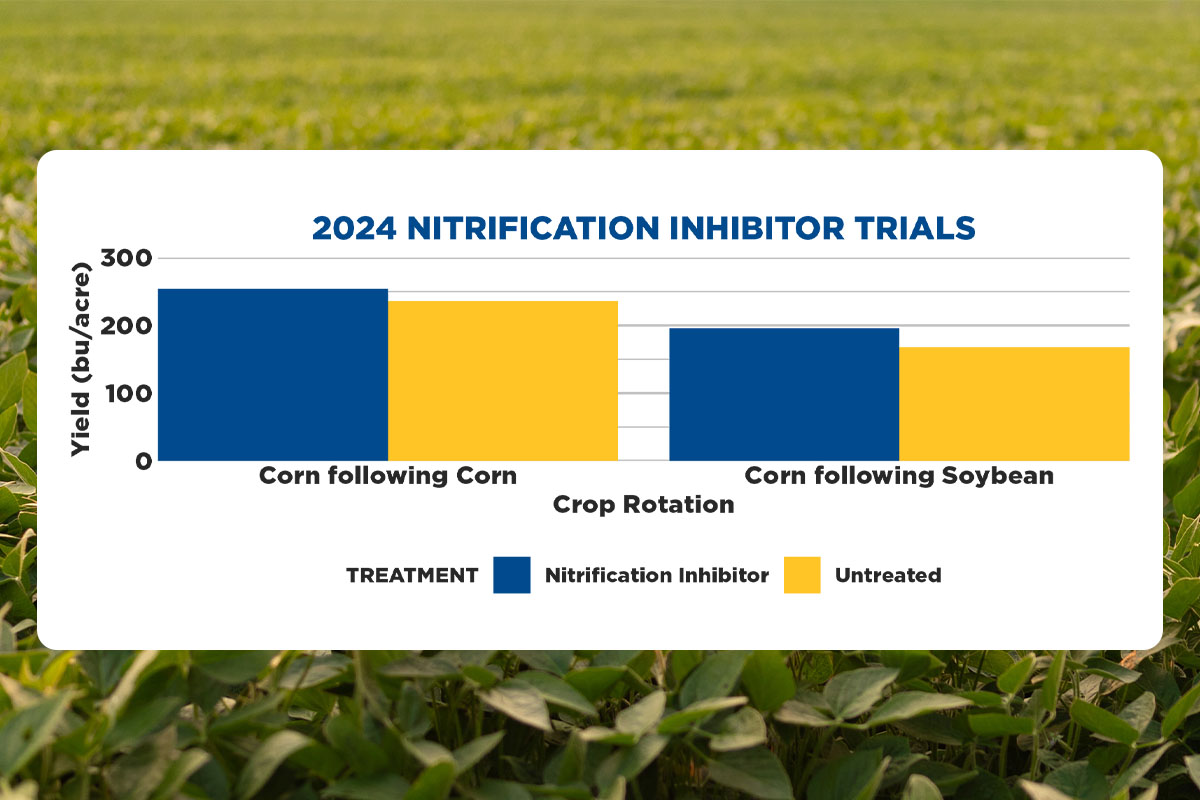
(Photo: Iowa Soybean Association / File Photo)
Protect your input investments
August 5, 2025 | Shane Beck, CCA
Key takeaways:
- In 2024, nitrogen inhibitors protected 18-28 bushels per acre of corn yield.
- Weather during the winter and spring of 2024 promoted conversion to unstable forms of soil nitrogen and allowed it to leach from soil.
- One year with high protection of nitrogen can pay for the next few years of nitrogen inhibitors.
Nitrogen is one of the most important nutrients and a significant cost required to grow a bushel of corn. Nitrogen is required for optimal growth, including chlorophyll production, and to achieve yield potential.
It takes anywhere from 0.6 to 1.2 pounds of nitrogen to produce a bushel of corn. This means that to grow 250 bushels per acre of corn, we would need between 150 and 300 pounds of nitrogen.
Keeping nitrogen in place
Nitrogen can be lost from the soil through leaching throughout the soil profile, with soil particles through erosion or volatilization when exposed to the environment. How can producers protect the nitrogen once it is applied and ensure that it is available for plants when it is needed?
One way to do this is through nitrogen stabilizers, which help protect nitrogen by slowing down chemical reactions in the soil. This keeps the nitrogen from leaving the soil either through leaching in the soil with water or volatilizing into the atmosphere.
There are two types of nitrogen stabilizers: urease inhibitors and denitrification inhibitors. The urease inhibitors prevent the conversion of urea into ammonia which can be volatilized into the atmosphere.
Denitrification inhibitors prevent the conversion of ammonia to nitrate, which can be easily leached through the soil and into surrounding streams.
Keeping nitrogen in the field protects the farmer's investment and the environment from added nitrates
to water sources.
ISA trial results
In 2024, the Iowa Soybean Association's (ISA) Research Center for Farming Innovation (RCFI) conducted two trials looking at the use of a denitrification inhibitor with anhydrous ammonia applied in the fall of 2023.
Both trials were applied in mid-November once soil temperature dropped below 50 degrees.
One of the trials was corn following corn and the other corn following soybeans. There were two different target rates for the fields. The corn following corn field had a target rate of 220 pounds of nitrogen per acre and the corn following soybean field had a target rate of 160 pounds of nitrogen per acre. There was no extra nitrogen added to the field throughout the growing season.
Winter weather is a factor that has a great influence over nitrogen conversion rates. The winter of 2023-2024 was unusually mild. Although there was a two-week window toward the middle of January where we saw temperatures dip significantly below 0 degrees, a thick layer of snow covered the ground insulating it from
the extreme cold temperatures.
The ground never froze during the winter due to the mild temperatures and the lack of moisture due to the drought during the summer of 2023. Additionally, the spring of 2024 was excessively wet. The combination of these weather conditions allowed for greater nitrogen leaching though the warmer soil conditions and higher rainfall early in the season.
Overall, we saw a significant positive yield response from applying the nitrogen inhibitor with the anhydrous ammonia in the fall of 2023.
The corn following corn field showed an 18 bushel-per-acre yield advantage with the nitrogen inhibitor compared to the area without the added nitrogen inhibitor.
The nitrogen use efficiency (NUE) was 0.87 pounds per bushel where the inhibitor was applied and 0.93 pounds per bushel where no inhibitor was applied. Whereas the corn following soybean trial experienced a 28 bushel-per-acre yield advantage when using the nitrogen inhibitor compared to the area without the inhibitor. The NUE was 0.82 pounds per bushel where the inhibitor was applied and 0.95 pounds per bushel where no inhibitor was applied.
The discrepancy in yields between fields is most likely due to the extra 60 pounds of nitrogen applied to the corn following corn field.
The cost of this nitrogen inhibitor was around $20 per acre, requiring a positive response of 4-5 bushels to the acre, at a market price of $4-5 per bushel for economic breakeven. As shown in the figure above, the fields achieved that easily with increases of 18 and 28 bushels.
Another way to think of this is that these results paid for the next four to six years of nitrogen stabilizer product because of the yield advantage from one year. Even if there is a year where the winter and spring are cold and dry, which will lead to very little nitrogen loss, there would be the benefit of previous years being profitable and absorbing this cost.
Protecting profit and the environment
Nitrogen stabilizers are valuable resources available to farmers. It can protect the farmer's investment from leaving the field before it is available to the plant. It also helps protect the environment and keep our water sources clean. Even though stabilizers may seem a little costly, nitrogen stabilizers can very easily pay for themselves when the weather conditions promote high rates of nitrogen conversion.
Looking beyond 2025, ISA's research agronomy team plans to conduct more research on this topic. ISA will analyze more individual farmer-submitted nitrogen inhibitor trials in the 2025 growing season and will conduct replicated strip trial studies focusing on the use of nitrogen inhibitors with anhydrous ammonia and timing of the application. These trials will look at yield and how nitrogen moves throughout the soil profile by conducting regular soil samples.
Written by Shane Beck.
Back